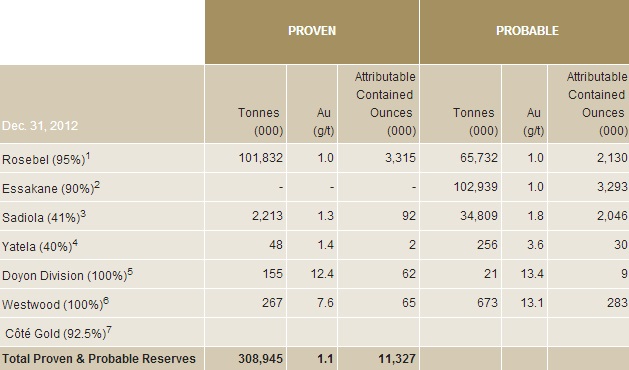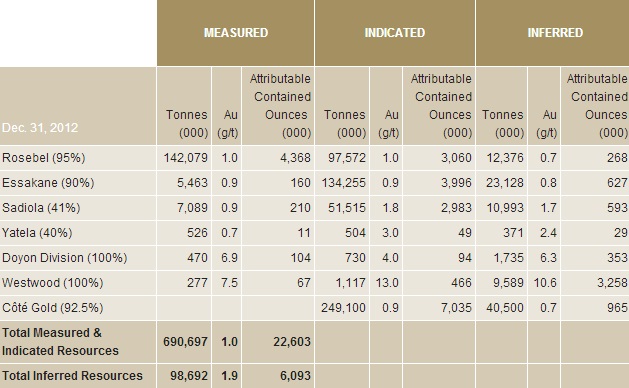Mineral reserves and mineral resources have been estimated in accordance with NI 43-101.
4 Refer to the 43-101 Technical Report filed on SEDAR.
Notes to Investors Regarding the Use of Resources
Cautionary Note to Investors Concerning Estimates of Measured and Indicated Resources
This website uses the terms "measured resources" and "indicated resources". We advise investors that while those terms are recognized and required by Canadian regulations, the United States Securities and Exchange Commission (the “SEC”) does not recognize them. Investors are cautioned not to assume that any part or all of mineral deposits in these categories will ever be converted into reserves.
Cautionary Note to Investors Concerning Estimates of Inferred Resources
This website also uses the term "inferred resources". We advise investors that while this term is recognized and required by Canadian regulations, the SEC does not recognize it. "Inferred resources" have a great amount of uncertainty as to their existence, and great uncertainty as to their economic and legal feasibility. It cannot be assumed that all or any part of an inferred mineral resource will ever be upgraded to a higher category. Under Canadian rules, estimates of inferred mineral resources may not form the basis of feasibility or pre-feasibility studies, except in rare cases. Investors are cautioned not to assume that part or all of an inferred resource exists, or is economically or legally mineable.
Scientific and Technical Disclosure
IAMGOLD is reporting mineral resource and reserve estimates in accordance with the CIM guidelines for the estimation, classification and reporting of resources and reserves.
Cautionary Note to U.S. Investors
The SEC limits disclosure for U.S. reporting purposes to mineral deposits that a company can economically and legally extract or produce. IAMGOLD uses certain terms in this website, such as "measured," "indicated," or "inferred," which may not be consistent with the reserve definitions established by the SEC. U.S. investors are urged to consider closely the disclosure in the IAMGOLD Annual Reports on Forms 40-F. You can review and obtain copies of these filings from the SEC's website at http://www.sec.gov/edgar.shtml or by contacting the Investor Relations department.
The Canadian Securities Administrators' National Instrument 43-101 ("NI 43-101") requires mining companies to disclose reserves and resources using the subcategories of "proven" reserves, "probable" reserves, "measured" resources, "indicated" resources and "inferred" resources. Mineral resources that are not mineral reserves do not demonstrate economic viability.
A mineral reserve is the economically mineable part of a measured or indicated mineral resource demonstrated by at least a preliminary feasibility study. This study must include adequate information on mining, processing, metallurgical, economic and other relevant factors that demonstrate, at the time of reporting, that economic extraction can be justified. A mineral reserve includes diluting materials and allows for losses that may occur when the material is mined. A proven mineral reserve is the economically mineable part of a measured mineral resource demonstrated by at least a preliminary feasibility study. A probable mineral reserve is the economically mineable part of an indicated, and in some circumstances, a measured mineral resource demonstrated by at least a preliminary feasibility study.
A mineral resource is a concentration or occurrence of natural, solid, inorganic material, or natural, solid fossilized organic material including base and precious metals in or on the Earth's crust in such form and quantity and of such a grade or quality that it has reasonable prospects for economic extraction. The location, quantity, grade, geological characteristics and continuity of a mineral resource are known, estimated or interpreted from specific geological evidence and knowledge. A measured mineral resource is that part of a mineral resource for which quantity, grade or quality, densities, shape and physical characteristics are so well established that they can be estimated with confidence sufficient to allow the appropriate application of technical and economic parameters, to support production planning and evaluation of the economic viability of the deposit. The estimate is based on detailed and reliable exploration, sampling and testing information gathered through appropriate techniques from locations such as outcrops, trenches, pits, workings and drill holes that are spaced closely enough to confirm both geological and grade continuity. An indicated mineral resource is that part of a mineral resource for which quantity, grade or quality, densities, shape and physical characteristics can be estimated with a level of confidence sufficient to allow the appropriate application of technical and economic parameters, to support mine planning and evaluation of the economic viability of the deposit. The estimate is based on detailed and reliable exploration and testing information gathered through appropriate techniques from locations such as outcrops, trenches, pits, workings and drill holes that are spaced closely enough for geological and grade continuity to be reasonably assumed. An inferred mineral resource is that part of a mineral resource for which quantity and grade or quality can be estimated on the basis of geological evidence and limited sampling and reasonably assumed, but not verified, geological and grade continuity. The estimate is based on limited information and sampling gathered through appropriate techniques from locations such as outcrops, trenches, pits, workings and drill holes. Mineral resources which are not mineral reserves do not have demonstrated economic viability.
Investors are cautioned not to assume that part or all of an inferred resource exists, or is economically or legally mineable.
A feasibility study is a comprehensive technical and economic study of the selected development option for a mineral project that includes appropriately detailed assessments of realistically assumed mining, processing, metallurgical, economic, marketing, legal, environmental, social and governmental considerations together with any other relevant operational factors and detailed financial analysis, that are necessary to demonstrate at the time of reporting that extraction is reasonably justified (economically mineable). The results of the study may reasonably serve as the basis for a final decision by a proponent or financial institution to proceed with, or finance, the development of the project. The confidence level of the study will be higher than that of a pre-feasibility Study.
A pre-feasibility Study is a comprehensive study of a range of options for the technical and economic viability of a mineral project that has advanced to a stage where a preferred mining method, in the case of underground mining, or the pit configuration, in the case of an open pit, is established and an effective method of mineral processing is determined. It includes a financial analysis based on reasonable assumptions on mining, processing, metallurgical, economic, marketing, legal, environmental, social and governmental considerations and the evaluation of any other relevant factors which are sufficient for a qualified person, acting reasonably, to determine if all or part of the Mineral Resource may be classified as a Mineral Reserve.
Gold, Niobium and TREO Technical Information and Qualified Person/Quality Control Notes
The mineral resource estimates contained in this website have been prepared in accordance with National Instrument 43-101 Standards of Disclosure for Mineral Projects (“NI 43-101”) and JORC. The “Qualified Person” responsible for the supervision of the preparation and review of all resource and reserve estimates for IAMGOLD Corporation is Réjean Sirois, Eng., Vice President, Geology & Resources for G Mining Services Inc. Réjean worked for 25 years with IAMGOLD Corporation and has an excellent knowledge of all the operations and projects. He is considered a “Qualified Person” for the purposes of National Instrument 43-101 with respect to the mineralization being reported on. The technical information has been included herein with the consent and prior review of the above noted Qualified Person. The Qualified person has verified the data disclosed, and data underlying the information or opinions contained herein.
Forward Looking Statement
This website contains forward-looking statements. All statements, other than of historical fact, that address activities, events or developments that the Company believes, expects or anticipates will or may occur in the future (including, without limitation, statements regarding expected, estimated or planned gold and niobium production, cash costs, margin expansion, capital expenditures and exploration expenditures and statements regarding the estimation of mineral resources, exploration results, potential mineralization, potential mineral resources and mineral reserves) are forward-looking statements. Forward-looking statements are generally identifiable by use of the words “may”, “will”, “should”, “continue”, “expect”, “anticipate”, “estimate”, “believe”, “intend”, “plan” or “project” or the negative of these words or other variations on these words or comparable terminology. Forward-looking statements are subject to a number of risks and uncertainties, many of which are beyond the Company’s ability to control or predict, that may cause the actual results of the Company to differ materially from those discussed in the forward-looking statements. Factors that could cause actual results or events to differ materially from current expectations include, among other things, without limitation, failure to meet expected, estimated or planned gold and niobium production, cash costs, margin expansion, capital expenditures and exploration expenditures and failure to establish estimated mineral resources, the possibility that future exploration results will not be consistent with the Company's expectations, changes in world gold markets and other risks disclosed in IAMGOLD’s most recent Form 40-F/Annual Information Form on file with the United States Securities and Exchange Commission and Canadian provincial securities regulatory authorities. Any forward-looking statement speaks only as of the date on which it is made and, except as may be required by applicable securities laws, the Company disclaims any intent or obligation to update any forward-looking statement.




